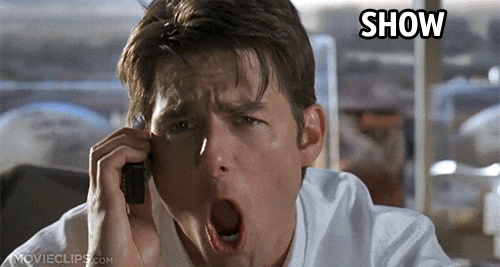It’s time to forget everything you think you know about Brand Strategy. Here’s why.
So, he wrote a mission statement. A manifesto. And he emailed it to the entire company:
“We all believe our work to be too important to stop, minute to minute, for something that might interfere with the restless and relentless pursuit of forward motion. Of greater success..
“The whole success cycle dooms the very thing that causes the success in the first place … It makes us all forget that monetary success comes from something very pure. It comes from a desire to do well, to make life better…
“The answer is fewer clients. Less dancing. More truth. We must crack open the tightly clenched fist of commerce and give a little back for the greater good.”
The next day, he got fired.
That sports attorney’s name was Jerry Maguire, and he was not a real person. He was the main character in an Oscar-winning movie of the same name, directed by Cameron Crowe and starring Tom Cruise, Renée Zellweger, and Cuba Gooding, Jr.
In an era before social media, smartphones, or the internet as we know it existed, this movie swept through popular culture on a level that’s hard to overstate. Jerry Maguire quotes wove their way into our lexicon and never let go:
Why was this movie so pervasive?
Jerry Maguire ranks 18th in box office earnings for that year (Independence Day was #1, in case you were wondering), and nobody’s going around quoting Mission: Impossible, also starring Tom Cruise, which came out earlier that year and brought in more than twice what Maguire did.
That's because cameron crowe is a master storyteller. he knows how to make his audiences feel, and a deeply felt moment is a *remembered* moment.
Jerry Maguire had all the ingredients of a great story—a handsome, dorky white guy genuinely trying to be a better person; a very adorable child actor. Well-written dialogue. A David-vs.-Goliath vibe. Regina King…
But most of all, it achieved a deep human connection with its viewers. They could SEE THEMSELVES in these characters. They felt inspired and moved and their faith in humanity was restored a little bit. They laughed, then cried, then laughed again through the tears. Which is exactly how you’ll feel when you watch Cuba Gooding, Jr.’s off-the-chain Oscar acceptance speech for his role in the film, which you should definitely do.
We’re not really here to talk about Jerry Maguire, though.
We're here to talk about stories.
Throughout history we have used stories to contextualize and frame our reality. without story, we are disoriented. we don't know which way to go; we're blind; we're lost.
Your brand is a compass, a flashlight cutting a clear path through the morass of competing voices, showing your audience which way to go in order to get what it is they seek. As a business owner, entrepreneur, or personal brand, your success and longevity is directly dependent on your ability to connect with your ideal customer, to make sure they can locate you, and to make sure they feel seen, heard, and well taken care of once they get there.
The status quo—let’s call it Brand Strategy 1.0—is overwhelmingly focused on the visual expression of brand. The colors; the logos; eye-catching web design; luxe photo shoots. In the 1.0 Paradigm, when you hire a branding agency, you often receive a Brand Book that contains page after page of visual guidelines, including font selection, logo variations, social media templates, and examples of how to mix and match your color palette.
It all feels very cool and sexy… but we would argue it’s only a small piece of the branding puzzle. More on this in a minute.
The prevailing vibe of Brand Strategy 101 is that it’s not for everyone. Most big branding agencies today are descendants of the old-school, Madison Avenue forefathers of marketing and branding (think the David Ogilvys of the world). This paradigm was dreamed up and developed by white men in suits, and even though those guys KNEW they were selling to people who weren’t white men in suits—people with different genders, identities, backgrounds, and skin color—they didn’t exactly invite any of those folks into the boardroom with them.
Of course we can look back on this with 2023 eyes and see the folly of this approach—how can you speak your customers’ language if you’re not actually inviting them to the table?—but at the time, concepts like marketing, copywriting, and brand development were like a new frontier. The possibilities were so intoxicating, and the ROI was rolling in, and there wasn’t anybody around to ask 2023-style questions. (And even if there had been, the guys in suits probably wouldn’t have listened anyway.)
As the decades passed, branding agencies built on the 1.0 foundation, and sort of just kept doing what was “working.” Agences copied other agencies, and high-level brand strategy became the purview of big-budget corporations; a luxury only the wealthiest personal brands could afford.
But all that’s done is make brand strategy inaccessible to most of the businesses who need it (and we think every business needs a brand; it’s how you communicate to and connect with your customers; it’s the “why” behind the work you do).
In an age where more and more individuals, consultants, and solopreneurs are putting their work out into the world, the Personal Brand has become ubiquitous—a necessity. But the existing paradigm hasn’t adapted. It hasn’t expanded. It no longer reflects the diversity, background, and motivations of all the small businesses out here who need a solid brand strategy.
We’ve even seen some schools of thought that suggest brand development should be an afterthought; an investment you only make once you’ve reached a certain level of revenue and disposable income. And while we agree that there are some business expenses that aren’t necessary until they make financial sense (that luxe photo shoot comes to mind), we think brand development should be priority #1, right from the jump.
Which is why we’re here, rewriting the paradigm, calling for a change.
INTRODUCING BRAND STRATEGY 2.0
We believe “brand” is a shared experience above all. It’s a common language, a shared understanding, a STORY that weaves through every single thing you say, write, sell, design, and do. Even your products, services, and pricing are reflections of that story—they connect you to your customer and represent what you stand for and why you do the work that you do.
Where the 1.0 Paradigm is overly focused on the visual elements, Brand Strategy 2.0 starts with WORDS. It starts by asking key foundational questions—and continuing to revisit those questions as your business grows and evolves.
Here’s what the process should look like‚
1. Market Research
Start by seeking out and listening to your ideal customer. What are your customers looking for, in their own words? What do they appreciate and value about you specifically? What problems do you solve; what benefits do your products or services provide—and WHY does that matter?
2. Strategic Positioning
Who is doing similar work to you, and how is what you do different from them? What other brands will your customers be looking at, and what would tip the balance in your favor? Your positioning comes from your unique point of view, your “why,” your values, and how that fits into the existing ecosystem your brand will live in.
3. Brand Voice Development
When humans interact with words and messages on a screen, they hear a voice in their heads. It’s subtle, and maybe not always conscious, but you are literally talking to them in that moment. Your brand voice is something that should be carefully curated through market research and positioning work, so that when your customer “hears” it, they instantly feel a kinship and connection with you. You want them to know right away that this is FOR THEM.
4. Brand Identity Design
NOW come the sexy visuals. All your visual elements should flow from and be a reflection of your Strategic Positioning, voice, and personality. Design should support these elements; not define them.
5. Results Driven Marketing
This all flows into revenue generation. Once you’ve identified your voice and positioning strategy, and taken the time to develop a deep understanding of your customers and competitors, you’ll be able to develop a marketing strategy that puts your brand in front of the right people, in the right places, at the right time.
The most powerful, memorable brands excel at one thing above all others—human connection. Coca-Cola isn’t memorable because of their white-on-red colorstory; the red-on-white colorstory is memorable because it symbolizes what Coca-Cola wants to be known for—friendship, diversity, building bridges.
But giant, nationally known brands are only useful as examples because most everyone can conjure up that Coca-Cola logo, and the cultural power of that brand is a universally understood phenomenon. One reason so many people all over the world feel the way they do about Coke, is because they’ve been around for so long and are already well-established. We can take inspiration from companies like Gucci or big well-known personal brands like The Kardashian family, but how does that translate into smaller, more intimate, lesser known personal brands like the ones most small businesses are working to develop?
The first step is to understand that brand is NOT an afterthought; it should live at the bottom of the pyramid. It’s absolutely necessary and vital to the long-term success and sustainability of your company.
The next is to ditch the misconception that brand strategy is the same thing as your brand’s visual identity. The visuals are just a piece of your overall positioning strategy, and should flow from your values, voice, and story.
Finally, consider working with an expert brand positioning strategist and copywriter. These are the creative minds who understand how to translate what you do into a Maguire-level story that makes your customers feel so moved and compelled, they’ll talk about you for decades to come. The thinkers and writers who will plumb the depths of their talent for you; the reason a 27-year-old movie still feels relevant today.
Brands are stories that help us see and understand. And that seeing and understanding is vitally important, not just for outbound marketing but internally as well. It’s how you’ll retain your best accounts and keep your clients happy. It’s why you’ll attract and retain talent, and it’s how you’ll curate a company culture that people—including you—actually want to be a part of.
This is OUR manifesto.
P.S. The original Space Jam also came out in 1996, and ranks #15 in box office earnings. Jordan must have had a hell of a sports agent. 😎



